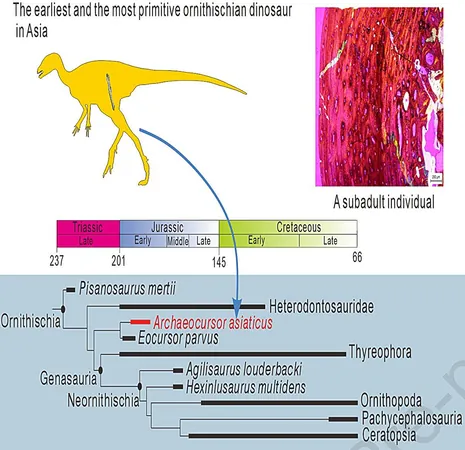
New Dinosaur Discovery, Archaeocursor asiaticus, Unravels Secrets of Early Migration Between Gondwana and Laurasia
2024-12-30
Author: Li
New Dinosaur Discovery, Archaeocursor asiaticus, Unravels Secrets of Early Migration Between Gondwana and Laurasia
A groundbreaking discovery in southwestern China has unveiled Archaeocursor asiaticus, which is poised to be recognized as the earliest-known ornithischian dinosaur in Asia. This exciting find, resulting from a collaborative study across multiple Chinese institutions, suggests a significant migration event for ornithischians from Gondwana to Laurasia, separate from the movements of armored dinosaur species.
Ornithischians are a diverse group of dinosaurs that include well-known descendants like ankylosaurs, stegosaurs, hadrosaurs, ceratopsians, and pachycephalosaurs. Despite the wealth of knowledge surrounding these later forms, the early evolutionary origins of Ornithischia remain somewhat enigmatic.
To better understand this ancient migration, it is essential to note the geographical split that existed millions of years ago. Gondwana comprised regions that are now South America, Africa, India, Madagascar, Australia, and Antarctica, while Laurasia included modern-day North America, northern Asia, Greenland, and Europe. The distinction between these landmasses holds critical clues to the distribution and evolution of early dinosaur species.
Fossil evidence from the Early Jurassic indicates a richer diversity of ornithischian remains in the lands that were once part of Gondwana, with far fewer finds coming from Laurasian territories. This imbalance suggests that Gondwana may well have been the cradle of these early dinosaurs.
Published in a pre-proof format in iScience, a detailed study titled "New Evidence for the Earliest Ornithischian Dinosaurs from Asia" highlights a nearly complete left femur excavated from the Lower Jurassic Ziliujing Formation. Measuring an impressive 93 mm in length, the femur indicates that Archaeocursor asiaticus was likely a small-bodied dinosaur, with a total body length of around one meter.
Osteohistological examinations of the specimen reveal insights into its growth and maturity. The parallel-fibred bone structure and tightly packed lines of arrested growth suggest that this individual was a young adult at the time of its death, further illuminating the life history of these ancient creatures.
Utilizing advanced imaging technology such as high-resolution CT scans, researchers documented distinct morphological traits of Archaeocursor asiaticus. These included a notable ridge on the femoral proximal surface, a broad fourth trochanter, and a uniquely shaped medial condyle. Critically, these findings not only set Archaeocursor asiaticus apart from its contemporary ornithischians, such as Yuxisaurus kopchicki, but also align it more closely with those taxa found in Gondwana.
Phylogenetic analyses position Archaeocursor asiaticus at an early branch within the Ornithischia clade, suggesting it may have existed prior to the arrival of armored dinosaurs in the region. This discovery underlines the likelihood of an additional dispersal event of ornithischian dinosaurs into East Asia, supporting theories that suggest a rapid diversification during the Early Jurassic period.
As paleontologists continue to delve deeper into the secrets of our planet's prehistoric past, discoveries like Archaeocursor asiaticus provide invaluable insights into the evolutionary pathways and migratory behaviors of these remarkable creatures, reshaping our understanding of how they spread across ancient continents. Stay tuned for further updates as this story unfolds!




 Brasil (PT)
Brasil (PT)
 Canada (EN)
Canada (EN)
 Chile (ES)
Chile (ES)
 Česko (CS)
Česko (CS)
 대한민국 (KO)
대한민국 (KO)
 España (ES)
España (ES)
 France (FR)
France (FR)
 Hong Kong (EN)
Hong Kong (EN)
 Italia (IT)
Italia (IT)
 日本 (JA)
日本 (JA)
 Magyarország (HU)
Magyarország (HU)
 Norge (NO)
Norge (NO)
 Polska (PL)
Polska (PL)
 Schweiz (DE)
Schweiz (DE)
 Singapore (EN)
Singapore (EN)
 Sverige (SV)
Sverige (SV)
 Suomi (FI)
Suomi (FI)
 Türkiye (TR)
Türkiye (TR)
 الإمارات العربية المتحدة (AR)
الإمارات العربية المتحدة (AR)